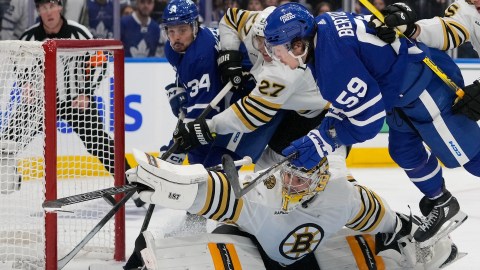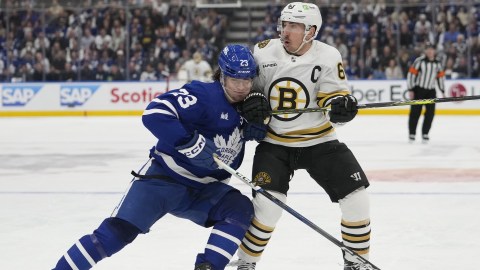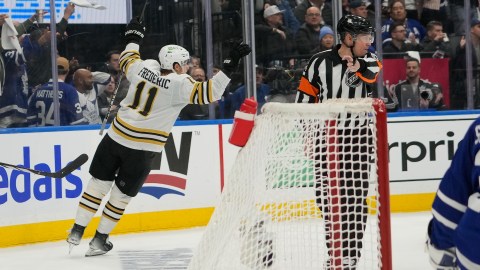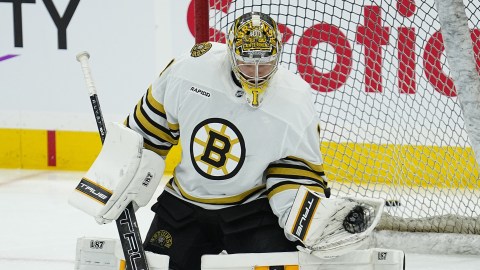The field of 16 in Boston’s Biggest Sports Legend tournament has enough legendary moments to fill an encyclopedia. Here are their greatest hits.
Red Auerbach
What Red Auerbach pulled on draft day throughout his long, storied career with the Celtics was downright sly, crafty and cunning. And it all started when he picked the most dominant player in the history of the sport in 1956, by grabbing Bill Russell No. 2 overall.
Auerbach was entering his fifth year at the Celtics’ helm, and with smooth guard Bob Cousy in his second year, Auerbach felt the C’s needed a defensive player who could dominate the boards to take their club to the next level. Some kid named Russell from San Francisco seemed to fit that mold, and Auerbach devised a plan to grab him.
He knew that the Rochester Royals were going to nab Sihugo Green out of Duquesne with the No. 1 pick, so he went a-knocking on St. Louis’ door with an interesting trade offer for the second choice. Auerbach sent All-Star forward Ed Macauley and Cliff Hagan to St. Louis for the No. 2 pick.
Russell became one of the most dominant centers in the game and arguably one of the sport’s greatest of all time. He made 12 All-Star appearances, captured five MVPs and nabbed three First-Team All-NBA honors, as well as a spot in the Hall of Fame. Oh yeah, he also won 11 NBA titles and the recognition as pilot to one of the greatest dynasties in all of sports.
None of that would have been possible without Red Auerbach and his resourceful draft-day ways.
Bill Belichick
Bill Belichick is a legend in New England after bringing three Super Bowl titles to Foxboro. But his arrival to the Patriots was legendary in its own right.
When Bill Parcells left New England after the 1996 season and joined the New York Jets, he brought Belichick — his assistant coach and secondary coach — along with him. The departure was anything but pleasant between Parcells and Patriots owner Robert Kraft, since the Jets engaged in shady tactics to work around Parcells being bound to the Pats.
Belichick spent three seasons with the Jets as assistant head coach and defensive backs coach, but after the Pete Carroll era came to a swift end for the Patriots in 1999, Kraft made it known he intended to hire Belichick as a replacement. In a desperate attempt to prevent Kraft from doing this (teams cannot block other teams from hiring people for a role that would be a promotion, but they can do so for lateral moves), Parcells stepped down as head coach, automatically elevating Belichick to the top-dog role.
Not so fast. A day later, Belichick wrote “I resign as HC of the NYJ” on scrap paper and ushered in the greatest era in New England football history.
Larry Bird
The Celtics’ legend set the standard for unbelievable playoff performances, and never was that more evident than in 1986. Fueling Boston’s final championship with the original Big Three (Kevin McHale and Robert Parish), Bird went off for 29 points, 12 assists and 11 rebounds in Game 6 of the NBA Finals against the Rockets.
Many consider that triple-double to be the best performance of Bird’s career, but that was far from the only spectacular stat line he put forth during those Finals. He was named MVP after averaging 24 points, 10 rebounds and 10 assists per game en route to his third straight league MVP award.
Ray Bourque
Ray Bourque grew an attachment to No. 7 in his first eight seasons with Boston. But the gracious captain didn’t hesitate to give the digits to another Bruins legend who wore the same number. On Dec. 3, 1987, Bourque surrendered the jersey to Phil Esposito, when the Garden honored the two-time Stanley Cup champion on "Phil Esposito Night."
It was the end of Bourque’s No. 7 era, and when he removed his jersey to reveal a second Bruins' sweater — No. 77 – he quickly established his own identity in the Boston sports world
Tom Brady
Tom Brady introduced himself to the world with one magical drive in the fourth quarter of Super Bowl XXXVI.
After Kurt Warner, quarterback of the "Greatest Show on Turf," tied the score at 17 with 1:30 left in the game, the rookie Patriots signal-caller took over with no timeouts left at their own 17-yard line.
New England probably could have run out the clock and headed into overtime, but Tom Brady likely wouldn't be the Tom Brady we know him today if it did so.
The Patriots began the drive with baby steps: a four-yard completion to J.R. Redmond, followed by another check-down pass to Redmond for nine yards. From the 30, guess who? Redmond again, this time for 11 yards, just barely making it out of bounds to stop the clock.
The 24-year-old quarterback then rattled off his only incomplete pass of the drive (not counting an upcoming spike to stop the clock), but quickly made up for it when he found the ageless Troy Brown on a crossing route. Brown took it 23 yards to the Rams' 36-yard marker with 29 seconds on the clock.
Then, Brady found tight end Jermaine Wiggins for six yards to get to the 30-yard line. One spiked ball later, and the stage was set for Adam Vinatieri.
Vinatieri's game-winning field goal capped off what Pats fans simply refer to as "The Drive" and sent Brady into legendary status. The quarterback went an amazing five-for-seven for 53 yards on the drive, where every play was a pass.
Gil Santos, New England Patriots radio commentator, summed up Brady’s work: "His complete game performance was not spectacular, but the final drive performance — that’s one of the great drives of all time."
Phil Esposito
Phil Esposito's accolades in a Bruins uniform were hard to keep track of — five Art Ross Trophies, two Hart Trophies and two Stanley Cups, just to point out a few — which makes it hard to point out one singular moment that defined his legendary career. However, the unstoppable efforts he put forth in the playoffs of 1970 and 1972 are perhaps the biggest reasons that the Bruins boast Stanley Cup banners from those seasons.
That's not to downplay the significance of teammates Bobby Orr, Gerry Cheevers, John McKenzie or Johnny Bucyk, but among them, nobody scored as much as Espo. In the 1970 playoffs, No. 7 led the league with 13 goals and 14 assists. In 1972, it was more of the same, as Esposito scored nine goals (tied with Ken Hodge and Bucyk for the team lead) and finished with 24 points (tied for the NHL lead). Thanks largely to Esposito, the Bruins won two Cups in three years — ending a 29-year drought.
Carlton Fisk
Everybody remembers Carlton Fisk’s iconic moment in a Red Sox uniform. In Game 6 of the 1975 World Series, Fisk cranked a 12th-inning pitch from Pat Darcy down the left-field line that won the game after landing above the Green Monster. However, it took some frantic body language from Fisk waving the ball fair before the outcome was determined.
Cameraman Lou Gerard, stationed in the Green Monster, taped what would become one of baseball’s more enduring images and forever changed how sports are presented on television. Up to that point, baseball cameramen were instructed to follow the flight of the ball, but Gerard was distracted by a rat and instead kept the camera trained on the catcher. After that moment, camera operators began to focus on the reaction of players, leading to future indelible moments such as Kirk Gibson’s joy at his walk-off home run in the 1988 Fall Classic.
John Havlicek
Everyone knows John Havlicek stole the ball in the 1965 Eastern Conference finals to advance to the NBA Finals, but not everyone knows what a warrior Havlicek was when a ring was on the line. In Game 6 of the 1974 Finals against the Milwaukee Bucks, Havlicek tied an overtime record with nine points. While the Green lost that game, Havlicek helped the Celtics beat Kareem Abdul-Jabbar’s squad in Game 7 and took home Finals MVP honors.
Two years later in Game 5 of NBA Finals against the Suns, Havlicek made what appeared to be the game-winning shot against Phoenix in double overtime. Celtics fans spilled onto court at the Garden, only to have referees decree there was one second left on the clock, allowing the Suns to tie the game at 112. Boston pulled out a 128-126 victory in triple overtime, and the game is widely considered the best ever played in NBA history. The Celtics won their 13th championship in Game 6, as Havlicek captured the eighth — and final — title of his 16-year career, an amazing stretch that began in 1962 and ended in 1978.
Cam Neely
When the Boston Bruins acquired Cam Neely prior to the 1986-87 season, they were getting a three-year veteran who had yet to post higher than 39 points in a season. Neely quickly became the definition of a power forward — a prolific goal-scorer who wasn’t afraid to use his fists.
After two consecutive 50-goal seasons, the sky was the limit for “Bam-Bam Cam” — until May 11, 1991. That’s the date of Game 3 of the 1991 Eastern Conference finals against the Pittsburgh Penguins. Ulf Samuelsson delivered what many consider a cheap hit to Neely’s knee, and the right winger never played more than 49 games in a season again. Neely later told Sports Illustrated, “Do I blame Ulf? Let's just say, I know when we play Pittsburgh next. I've known for a long time.”
Neely dropped his gloves when he and Samuelsson clashed on March 27, 1993, to get his revenge. But the Bruins were denied a long, healthy career from the 2005 Hall of Fame inductee.
Bobby Orr
Boston’s biggest hockey legend already cemented his place in Bruins history before he got a statue on May 10, 2010 — the 40th anniversary of his game-winning overtime goal against St. Louis that gave the B’s a Stanley Cup in 1970.
The statue was introduced prior to Game 5 of the Eastern Conference semifinals between the Bruins and the Flyers, and Orr was on hand for the festivities, addressing the crowd in front of the statue commemorating The Goal.
The statue is based on a photo by Ray Lussier, which famously shows Orr airborne after tallying the game-winner.
"It’s for an entire community," Orr told the crowd in front of the TD Garden. "A team and all of New England. That was a special moment for all the city of Boston and all of New England. It’s T-E-A-M, and we had a heck of a team."
David Ortiz
The Red Sox weren’t supposed to beat the Yankees. That much was simply understood when the Sox hosted the Yankees, down 3-0 in the ALCS, on Oct. 17, 2004. Yet somehow, the larger-than-life figure known as David Ortiz put an entire city — and decades of heartache — on his back, jacking a 12th-inning pitch over the Fenway fence and keeping hope alive at 1:22 a.m.
Ortiz eventually won Game 5 on a walk-off hit in Game 5, which started at 5 p.m. in Boston. In doing so, he became the first player in major league history to record two postseason walk-off hits in the same calendar day. It's a feat that is unlikely to ever be repeated.
Bill Russell
Celtics legend Bill Russell is perhaps the greatest winner to ever play team sports. Though championships are earned through team efforts, Russell's ability to will his team to victory was a trait that was evidenced again and again.
Sure, there's no statistic that can gauge clutch performances, but this one's close: In his career playing in college, the Olympics and the NBA, Russell played in 21 "do-or-die" games in which the winner moved on or won the championship and the loser's season ended. Russell's record in those games was 21-0. With the Celtics, Russell won 10 Game 7s en route to 11 NBA titles.
Adam Vinatieri
There is a single photo commemorating Adam Vinatieri’s greatest career achievement: It’s snowing on Jan. 19, 2002, and after Tom Brady was sacked by Charles Woodson, the quarterback appeared to fumble — but not so. The play was deemed a forward pass, thus setting up Vinatieri’s 45-yard field goal to force overtime. Vinatieri also notched the game-winning 23-yarder in overtime.
The kicks catapulted Vinatieri to cult-hero status in New England, and even after his three Super Bowl wins with the team, the moment that meant the most to him was the one that got it all started.
"I’ll always remember the Super Bowl kicks," the ex-Patriot told the Providence Journal. "Those are great memories. But if you ask me what was my best kick ever, I’d have to say the one against Oakland."
Ted Williams
There are plenty of mementos all over Fenway Park commemorating the career of one of the greatest hitters who ever lived — from a seat in the right-field bleachers marking the longest measurable home run ever hit inside the confines of America’s most beloved ballpark to the .406 Club, named in honor of his historic 1941 season. Ted Williams entered the final game of that regular season batting .39955, and he was given the option of sitting out a doubleheader on the last day. Like the true professional he was, he opted to play, registering six hits in his final eight at-bats. He finished with an average of .406 and is the last player to finish a season batting over .400.
In his book, Williams wrote, "I think, surely, to hit .400 you have to be an outstanding hitter having everything go just right, and in my case, the hitter was a guy who lived to hit, who worked at it so hard he matured at the bat at a time when he was near his peak physically. The peaks met."
That year, Williams also set a major league record for on-base percentage in a season at .551.
Carl Yastrzemski
When the Red Sox needed him most, Yaz was there. In the final weeks of the 1967 "Impossible Dream" season, the Sox needed wins to extend their memorable season into playoffs. The team was heading into potential three-way tie with Minnesota and Detroit, so Yaz did what any Hall of Famer would do: He took over.
In the final 12 games of the season, the Sox went 8-4 and Yaz had 23 hits in 44 at-bats for a .523 batting average with four doubles, five home runs, 14 runs scored and 16 RBIs.
The Red Sox needed to win the last two games at home against Minnesota to avoid a three-way tie with the Tigers and Twins, so Yaz decided to pick it up a little. Carl Michael Yastrzemski went 7-for-8 with five RBIs in those final two games — both of which were two-run wins. One of the game’s best defensive left fielders, Yaz also fired out Bob Allison at second base on what looked to be a sure double. And he smacked a three-run homer in the first game.
That hot streak also earned him arguably the sporting world’s most impressive feat: the elusive Triple Crown. Entering that final hot streak of 12 games, Yaz owned a .310 batting average and finished with a .326 BA, just .15 percentage points ahead of Frank Robinson’s .311 average for the AL batting title. Yaz, who is the last man to hit for the Triple Crown, posted 121 RBIs and 44 home runs (tying him with Harmon Killebrew) in that unforgettable season. He also led the league in on-base percentage (.418), slugging (.622), OPS (1.040), runs scored (112), total bases (360), hits (189) and extra-base hits (79).
Cy Young
Boston sports fans can recognize greatness, but they also hold special appreciation for attitude. Cy Young was lacking in neither. While he has nearly 100 more wins than any other pitcher in history and has thrown 1,300 more innings than anyone else, it was his accomplishment on May 5, 1904, that best defines Young.
Rube Waddell was a rival of Young's, and after the Philadelphia A's pitcher threw a one-hitter against Young and Boston, legend has it that Waddell taunted his counterpart. But three days later, Young made him pay. As Young induced a flyout from Waddell to record the 27th and final out in the first perfect game of the modern era (and first in AL history), Young snapped at Waddell: "How do you like that, you hayseed?"



